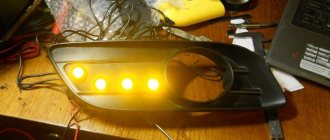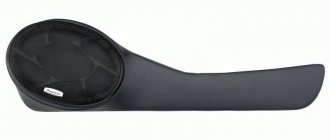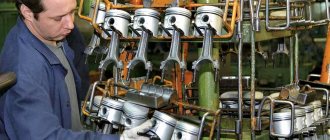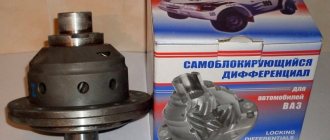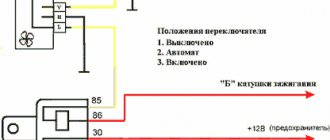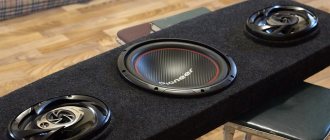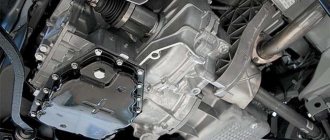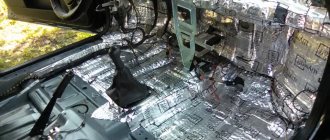Fasteners
For fastening, it is best to use yellow self-tapping screws with a length at least 2 times the wall thickness.
The heads of black ones often break off; they are thinner and not as strong. An advanced solution is furniture bolts, but if this is your first sub, then it will be easier with self-tapping screws. Yellow screws, black screws, furniture bolts.
Cage nuts for attaching the subwoofer to the cabinet are cool! The sub can also be secured with self-tapping screws, but with bolts in the mountings, the speaker is attracted as tightly as possible, and if necessary, it can be removed and installed as many times as necessary without damage. And the polished hex bolts look really cool.
Bolt with cage nut
Video about installing cage nuts (a more convenient option):
Glue
If you are sawing the walls with a jigsaw or a hand-held circular saw, then the glue will additionally act as a sealant between the uneven edges; any liquid wood nails will do for this. If you unraveled the material on the machine and the edges of the body walls are perfect, then apply the glue in a very thin layer, but still do not forget to coat the joints from the inside.
Terminal block
You can route the wires directly, but it is better to make a box for the subwoofer with a terminal block.
Terminal block for housing
Use threaded options - they are more reliable, or choose ones with fairly powerful springs. When installing the terminal block (terminal) for connecting the subwoofer, do not forget to tape the connection point with the housing around the perimeter. For round seats, it is convenient to cut a hole using a nozzle.
Round hole tool
Wires
You will need a piece of wire to connect the subwoofer coil to the output terminal block. Take any copper wire no thinner than 4 mm. in most cases this will be sufficient.
Tools
You will need:
- Circular saw - for cutting material, it can be either manual or stationary, it all depends on your capabilities. It is better not to cut with a jigsaw, the edges will be too uneven, even if you attach a guide bar, since the file can still wander.
Manual circular
- A jigsaw is for cutting out holes for the speaker and for the terminal block, it can also be a router, with its help the holes will be smooth and neat. To cut out the wall for a round terminal block, you can use a saw attachment. Select the right jigsaw blade for the job at hand.
- Screwdriver - for tightening screws and drilling holes.
Types of subwoofers
When figuring out how to make a subwoofer, it is necessary to evaluate the properties of the main types of these devices. The user can choose among the following varieties:
- Active subwoofer.
- Passive type models.
Active designs are available with an amplifier and crossover, which guarantees good sound with suppression of the high-frequency range. Such models can work with any sources.
Samples of the second group are not equipped with amplification units, and are connected to the standard radio. The disadvantage of a passive device is that the channels are fully loaded, which degrades the quality of the reproduced sound.
Depending on the design features, the following types of boxes are distinguished: open and closed boxes (CL). The former are built into the finishing elements of the interior, and the latter are made in the form of independent boxes, inside of which a speaker with a low-frequency range is installed.
Nuances
- It is important to make the turns correctly. These are pads installed in the inner corners of the labyrinth partitions to prevent an increase in the cross-sectional area of the port in places of turns. The distance between the edge of the horizontal partition and the rounding surface should be equal to the width of the tunnel on straight sections. Otherwise, when turning, you will get an hourglass shape, which will cause deviations in the tuning frequency values.
- Due to the structural features of the box, thanks to the large number of partitions, material for a subwoofer up to 12″ can be taken with a thickness of 16 mm.
- There is a type of CV, which is also called Rogozhin’s labyrinth. If you want to delve deeper into the theory and delve into the calculations, then here is a site where the developer’s work itself is presented.
What to make from
To make a subwoofer with your own hands, it is important to take care of the materials for its creation. First of all, you should prepare the following:
- Speakers. When choosing a speaker, you should evaluate its technical parameters: they must correspond to the capabilities of the car radio. If a new part is purchased, then all the characteristics will be indicated on the packaging or in the package insert.
- MDF sheets. Enclosures for subwoofers are also made from plywood, chipboard and fiberboard. The type of material is selected taking into account the dimensions of the future structure.
- Acoustic cable.
- Sealing compound or PVA glue.
- Fastening elements. They use self-tapping screws, since nails are prohibited for such work.
- Epoxy resin.
- Paint and varnish product.
Preparation
To make a subwoofer enclosure yourself you will need:
- Drawing;
- Materials: plywood or MDF, glue, screws, terminal block, wire for connection;
- Tools - jigsaw, screwdriver, pencil, template for mounting hole or compass.
Drawing
Having the housing parameters for the subwoofer in hand (volume, area and length of the port), you can make a drawing yourself using special programs (in my opinion, SketchUp from Google is the most convenient for this). But if you make the box for yourself, then there is no point in wasting time learning the software and doing everything the old fashioned way - by hand.
If you do not know how to calculate the enclosure, then read the material “How to calculate the enclosure for a subwoofer.” You can also order a paid estimate on the Internet; as a rule, it is accompanied by a clear drawing for manufacturing.
An example of a drawing of a housing with a bass reflex (FI)
Materials and fasteners
Housing material
In order to make a box for a subwoofer, you need a material that should vibrate as little as possible. From experience, it is best to use MDF (not painted, not laminated, etc.)
MDF (MDF - Medium Density Fiberboard). In Russian - medium density fiberboard.
MDF is easy to process, has good density, due to its structure it has no resonances and does not delaminate - the bass in such a box is soft and dense. MDF is more expensive than plywood and is “afraid” of moisture.
Plywood is the most common option and costs less than MDF.
Do not use chipboard or old furniture to make subwoofer boxes. A plywood or MDF body will always sound better.
If the walls are thick enough, there is no need to cover the inside of the body with vibration insulation, etc.!
Do not use material thinner than 18 mm. and the larger the volume of your case, the thicker the walls should be.
Many large stores that sell sheet material offer a cutting service to your dimensions, where they will cut the perfect parts for you on a machine, all that remains is to assemble the body.
Fasteners
For fastening, it is best to use yellow self-tapping screws with a length at least 2 times the wall thickness. The heads of black ones often break off; they are thinner and not as strong. An advanced solution is furniture bolts, but if this is your first sub, then it will be easier with self-tapping screws.
Yellow screws, black screws, furniture bolts.
Cage nuts for attaching the subwoofer to the cabinet are cool! The sub can also be secured with self-tapping screws, but with bolts in the mountings, the speaker is attracted as tightly as possible, and if necessary, it can be removed and installed as many times as necessary without damage. And the polished hex bolts look really cool.
Bolt with cage nut
If you are sawing the walls with a jigsaw or a hand-held circular saw, then the glue will additionally act as a sealant between the uneven edges; any liquid wood nails will do for this. If you unraveled the material on the machine and the edges of the body walls are perfect, then you do not need to use glue; it will be enough to coat the joints from the inside.
Terminal block
You can route the wires directly, but it is better to make a box for the subwoofer with a terminal block.
Terminal block for housing
Use threaded options - they are more reliable. For round seats, it is convenient to cut a hole using a nozzle.
Wires
You will need a piece of wire to connect the subwoofer coil to the output terminal block. Take any copper wire no thinner than 4 mm. in most cases this will be sufficient.
Tools
- Circular saw - for cutting material, it can be either manual or stationary, it all depends on your capabilities. It is better not to cut with a jigsaw, the edges will be too uneven, even if you attach a guide bar, since the file can still wander.
- A jigsaw is for cutting out holes for the speaker and for the terminal block, it can also be a router, with its help the holes will be smooth and neat. To cut out the wall for a round terminal block, you can use a saw attachment. Select the right jigsaw blade for the job at hand.
- Screwdriver - for tightening screws and drilling holes.
Which speaker to choose
To make a subwoofer from a regular speaker, you need to take a number of parameters into account, since they affect the size of the future speaker box. Often, inexperienced drivers make a mistake and choose a device based on power. However, these values only indicate the load capacity that the speaker can handle for an hour or a few seconds. Therefore, a powerful device does not guarantee good and clear sound.
When choosing a product, you first need to evaluate the properties of the diffuser. To get less distortion at peak volume, it is better to use large designs with a small amplitude of vibration.
Since the diffuser is subject to increased air resistance, the material from which it is made must be strong and reliable. Paper products are only suitable for “sound-in” speakers. Models based on polypropylene are sensitive to temperature changes and have minimal rigidity, which is why they are used in budget car acoustics. The best solution is considered to be carbon fiber and Kevlar.
As for metal acoustic systems, they provide precise sound production with intense resonance. However, these features only appeal to some users.
When choosing a speaker, its sensitivity is also taken into account. The characteristics can be assessed by the dimensions and power of the magnetic element.
You should also pay attention to the resonance frequency.
Varieties
Based on the type of construction, there are four types, each of them has its own characteristics and is capable of influencing the sound differently.
- Closed box. This box is easy to design, and its type of construction fully reflects the name. A subwoofer speaker placed in a closed box has a low efficiency, but its acoustic properties will still be significantly improved. It can be placed seamlessly anywhere in the car.
- A bass reflex is a housing containing a special tube that removes air, which significantly improves the quality and power of low-frequency sound.
- The fourth-order bandpass is divided into two chambers, one of which houses the subwoofer speaker, and the other chamber houses the air duct. With this type of design, the frequencies produced by the subwoofer can be adjusted.
- The sixth-order bandpass has the same principle as the previous version, but differs from it in the presence of an additional bass reflex. This type of design produces maximum efficiency, but its design and assembly is a very labor-intensive process.
Based on the above, we can conclude that the best option would be to manufacture a bass-reflex type box, because it is characterized by high efficiency and is easy to manufacture.
How to calculate a box
The calculation of the box is made using ready-made algorithms or from scratch. There are a lot of calculators on the Internet that allow you to make an accurate calculation for the case, determine what volume the box is needed and what the optimal dimensions are. To eliminate deviations, you need to take into account a number of rules.
First, let's calculate the volume of the subwoofer. For two speakers with a diagonal of 15 inches, it is better to calculate a 60-liter box, and for 12 inches, a 45-liter box. The optimal height is h=340 mm=34 cm=0.34 m, and the permissible length L=680 mm=68 cm=0.68 m. 1 liter = 1•10−3 m³ 1 l = 0.001 m³ then V= 45 l = 0.0 4 m³.
If the body will be located in the wing niche and have a complex geometric design, it is necessary to calculate the body for all parts, separating the volumes of both sides.
How to assemble a subwoofer
After preparing all the tools and materials, work on the construction of the structure can begin. Making a box for a 12-inch subwoofer with a diameter of 30 cm is quite simple. First of all, you should make a hole for the future speaker, maintaining a distance of 20 cm from the center to the walls.
Next you need to follow the following instructions:
- We are preparing the main elements of the future homemade building. Their parameters are calculated in advance on a trusted resource with online calculators.
- We make a hole in the front of the plywood sheet or MDF, chipboard.
- We cut a slot above the hole for the bass reflex tube and screw the compartment.
- We glue the side elements with PVA glue and fasten them with self-tapping screws. It is important to tighten the fasteners all the way, as any voids will negatively affect the sound quality.
- We cut out places for the wires at the back of the case.
- Before connecting all the components, we place the speaker in the box.
- The final stage involves finishing the interior space. Joints and crevices should be sealed with caulk or epoxy to improve sealing.
- External finishing consists of covering the body with carapet fabric. The carapet is stretched and secured with epoxy or a furniture stapler.
After completion of all stages, final assembly is carried out with connection to the standard car radio.
Since the closed bass reflex box (FI) is large in size, car owners prefer to install a compact “Stealth” subwoofer made by themselves. The mini model provides clear sound over a wide range of frequencies and takes up less space in the car.
In most cases, the box for the 10th subwoofer is placed in the trunk, but some people practice mounting it in the fender or spare tire niche.
The optimal volume for uninterrupted and high-quality operation of the device is 18 liters if 12-inch subs are used.
To properly make a box for a subwoofer, you can consider a simplified option by creating a closed box. It is created according to the same principles as the bass reflex model, but without making a gap. The ZYA has a hole for the speaker, so its design looks quite simple.
All kinds of bandpasses represent a full-fledged bass reflex, but in a modified format. Therefore, assembling a homemade sub is quite simple.
The most complex design is considered to be a subwoofer in the form of a horn. Due to the complexity of manufacturing, novice craftsmen abandon this option, preferring more simplified models. However, the horn is distinguished by volumetric lows and provides deep sound at all frequencies. But any deviation from the drawings will make all efforts useless, because... The sub won't sound right.
Therefore, experts recommend choosing the option of a closed box or bass reflex box for the subwoofer. The bandpass is also characterized by its simple design.
When assembling a box for a subwoofer, it is important to follow all safety rules and be careful. The work involves the use of piercing and cutting objects, as well as electric tools. The use of faulty devices is prohibited.
Drawing of a box for 2 12 subwoofers
The box for two 12 subwoofers can be made in different versions. The simplest option is two independent volumes, not interconnected, where each speaker has its own bass reflex. A more complex design would be a box with two speakers and a common air space. Such a case should also have two bass reflexes, and they should be configured differently. It is better to equip a box for 2 12-inch subwoofers with two tubular bass reflexes. In this case, the adjustment comes down to changing the length of the pipe. To do this, the tubular bass reflex has an internal segment that can be moved inside the main cylinder, changing its length.
How to install a subwoofer
Installing a subwoofer box in a car with your own hands is not a difficult task. However, for successful installation you need to have some skills and tools. In addition to placing the subwoofer and amplifier, you should take care of the following related devices:
- Circuit breakers.
- Wiring.
- Capacitors.
- Plastic clamps.
- Spanners.
- Electrical tape and wire cutters.
After choosing the optimal location for installing the subwoofer, you need to make sure that it can cope with resonances from the device. It is not allowed to place the box on fragile machine structures.
The wires are connected according to the following diagram:
- First you need to connect the cable to the amplifier.
- Next, the amplification unit is connected to the car radio.
- A cable with a positive value is wrapped in corrugation to protect it from deformation.
- The fuse is fixed on the same wire, maintaining a minimum distance between the batteries.
Before starting a homemade sub, it is important to check whether the battery is disconnected. This rule will allow you to protect yourself from electric shock and avoid damage to the radio.
Subwoofer enclosure assembly
To properly make a box for a subwoofer, before screwing in a self-tapping screw, drill a hole for it with a thin drill, this will increase the strength of the fastening and protect the plywood from delamination. Distribute the number of screws evenly along the length of the side and make sure that they do not meet at the corners.
Almost always a template for cutting out the mounting hole comes with the sub; it can be part of the box or be a separate attachment. Cut out the template, transfer it to the front side of the box and cut it out with a jigsaw or router.
Settings
The next step involves completely setting up the subwoofer. However, experts in the field of car audio recommend checking all parameters when designing the box in order to eliminate deviations and errors.
To properly configure the system, it is important to monitor the speaker parameters. If the model is characterized by high sound quality in a FI case, the port is adjusted both higher and lower, taking into account the music being played.
Setting up a low-pass filter begins by turning on this component. On factory subs it is called LPF (low pass filter).
Next, another filter called “sabsonic” is used, operating in the high-frequency range or sub-bass region. It is used to remove infra-low frequencies. However, not all amplifiers support this option, but if it does, it is better to activate it.
The task of the “subsonic” is to protect the subwoofer speaker from damage when playing frequencies that are outside the audible range, i.e. 20-25 Hz or lower. Working at such frequencies, the diffuser increases its stroke, which increases the risk of coil failure.
Experts recommend setting the filter 5 Hz below the frequency of the bass reflex port. If the selected frequency is 35 Hz, then the “Sabsonic” setting is performed at 30 Hz.
Particular attention should be paid to adjusting the acoustic phase. It helps the front speakers sound correctly together with the rear ones. If the sound is heard only from behind the car, it means that errors were made during setup.
Some amplifiers are equipped with a phase shifter “twist”, which ensures uniform phase rotation.
You should also set delays. This feature is only available on processor devices or when connecting external modules.
In many speaker systems, low frequencies are reproduced with a delay, which degrades the sound quality and does not allow you to fully enjoy your favorite song. To eliminate this problem, you need to make adjustments to the delays.
ChV calculation
The cross-sectional area of the port depends on the size of the speaker.
It is calculated in special programs; for averaged and simplified calculations, the effective diffuser area is taken.
It is important to know that the effective area (Sd) is not calculated by the standard size (10″, 12″, etc.), it is always smaller since the basket and part of the suspension do not participate in the radiation. Manufacturers often indicate this value in the documentation, but you can also calculate Sd
Sd —effective subwoofer area, cm²;
Sd = π(D/2)2
where D is the diameter in centimeters, taken through the center from the middle of the suspension.
For a square subwoofer, calculating the area is even simpler - you need to square the length of one side.
Effective area of subwoofers
The CV setting depends on the length of the port and is calculated as follows:
— port length, m.
Where:
Fb – desired tuning frequency, Hz
The optimal range is 35–45 Hz, no one forbids setting it low, if you like infra, lower the setting.
Calculation example
For example, let's calculate the frequency response with a setting of 38 Hz for a 12-inch (30 cm) speaker.
S port = 1.5 * 480 (from the table for 12″) = 720 cm²
In order for the box to fit into the car, the port is rolled up.
Possible malfunctions and repairs
Do-it-yourself subwoofer repair may be required if its elements are mechanically damaged. If the coil encounters an audio frequency that exceeds the permissible limit, it may fail. A similar problem occurs when listening to music at maximum gain, which causes the cone to rupture. Repairing the unit is quite simple, because it can be replaced with a new one.
Restoring the functionality of a diffuser or coil is a difficult task that will require a lot of time and effort, and every specialist who has repaired such a unit will recommend replacing it.
Overheating of the internal parts of the subwoofer often leads to breakdown. The problem is related to the contamination of the internal space with dust and technical debris. First, you need to evaluate the voltage in the power supply using a tester - if it is missing, you will have to replace the power supply.
When inspecting the interior, you may find swollen capacitors or blackened windings. Damaged elements need to be desoldered with a soldering iron and replaced with new, serviceable ones.
Speaker repair begins with disassembling and dismantling the subwoofer head. All actions must be performed without haste, since sudden movements can damage the reel sleeve.
Pros and cons of a homemade box
A homemade enclosure for subwoofer 12 has both pros and cons. The positive features of these products include:
- Saving money. The manufacturing process involves minimal monetary costs.
- Ease of DIY creation. If you stick to the drawings, correctly calculate the box and follow the step-by-step instructions, the work will not take much time.
- The ability to make a beautiful box for any interior geometry. When assembled, the small case will look stylish and give the car interior additional elegance.
The disadvantages include a limited set of functions and a number of problems when setting up the speaker system.
- What are tweeters in acoustics
- Car radio Soundmax SM CCR3064F
- Starline M15 manual
- How to find out the Tomahawk alarm model by key fob
